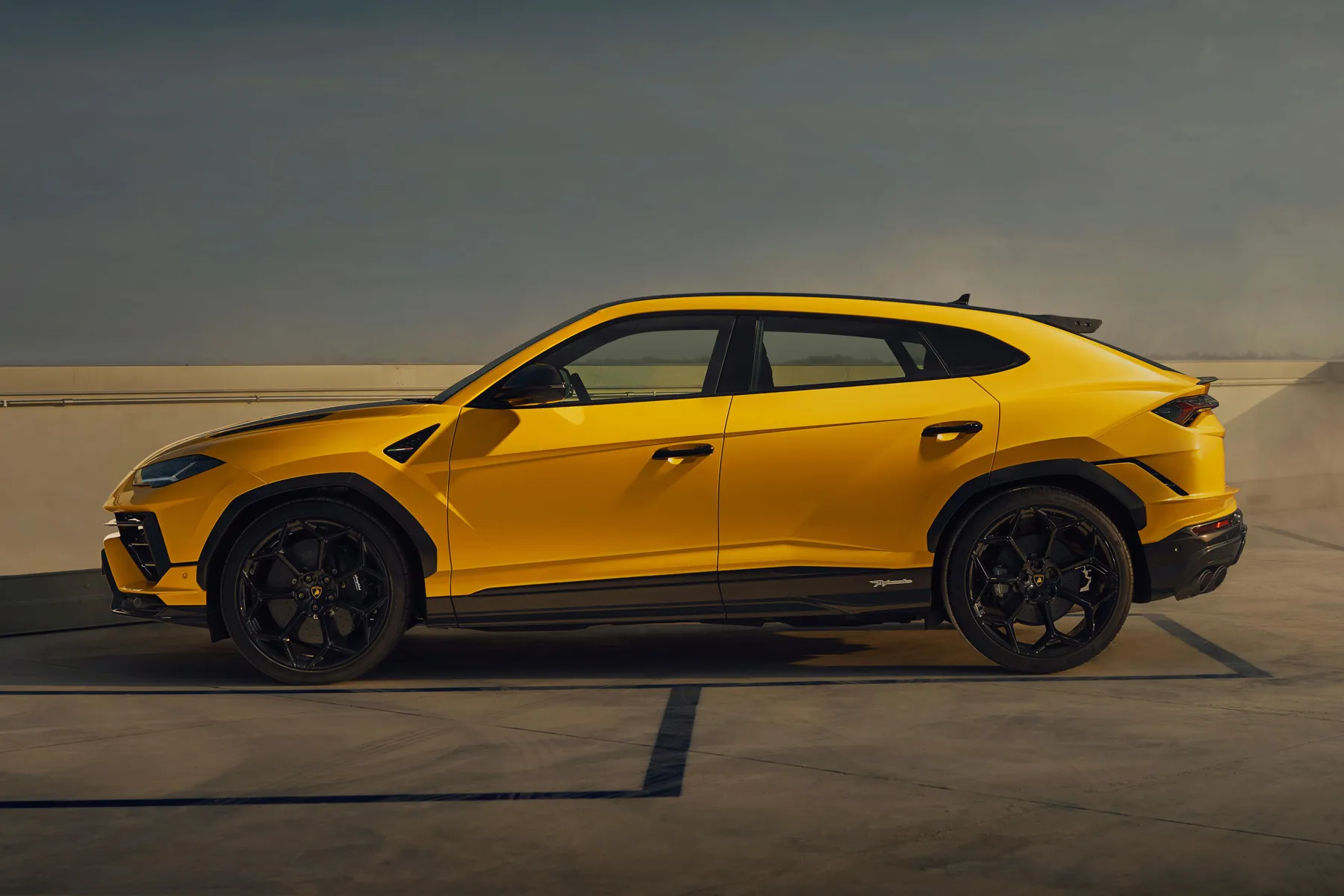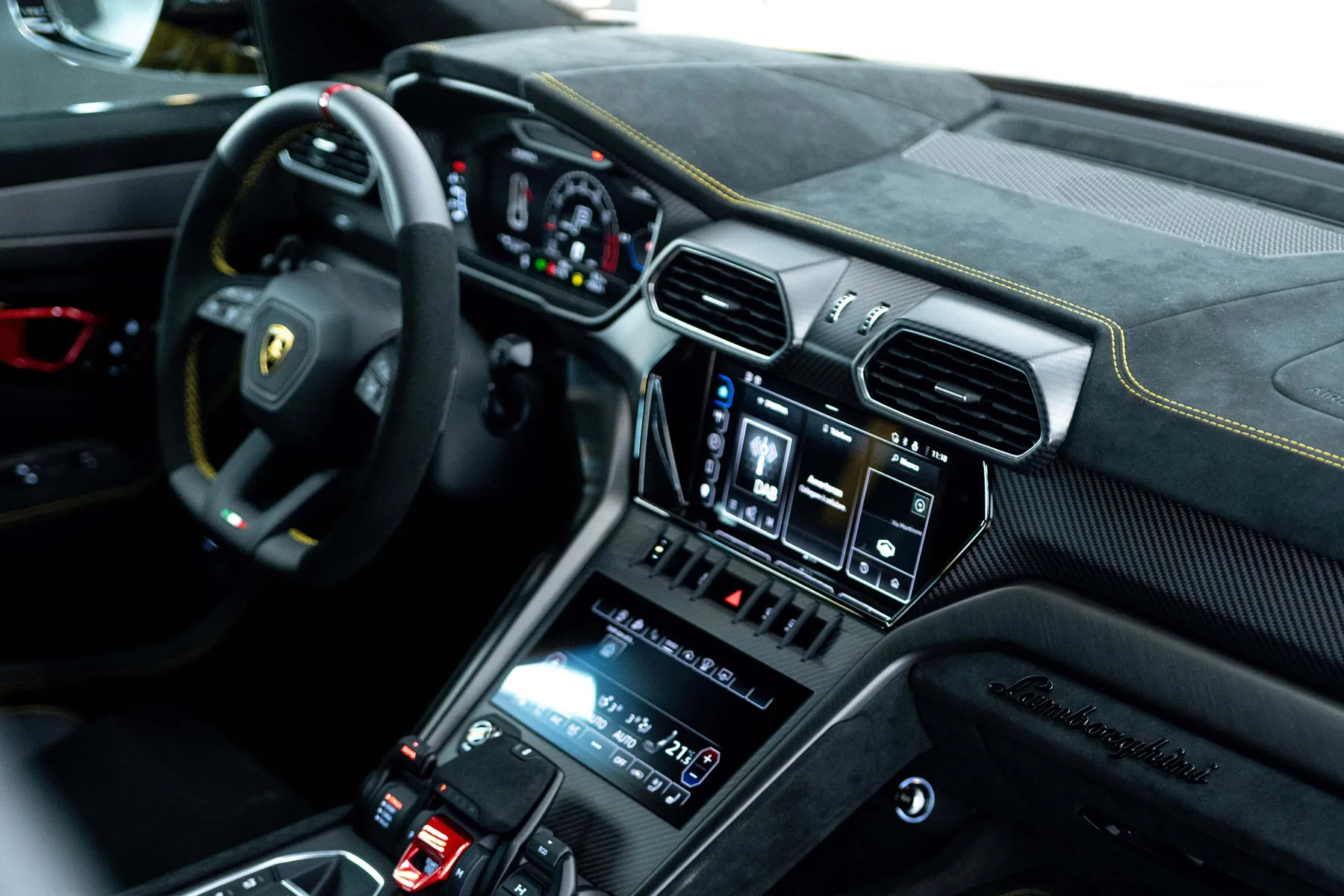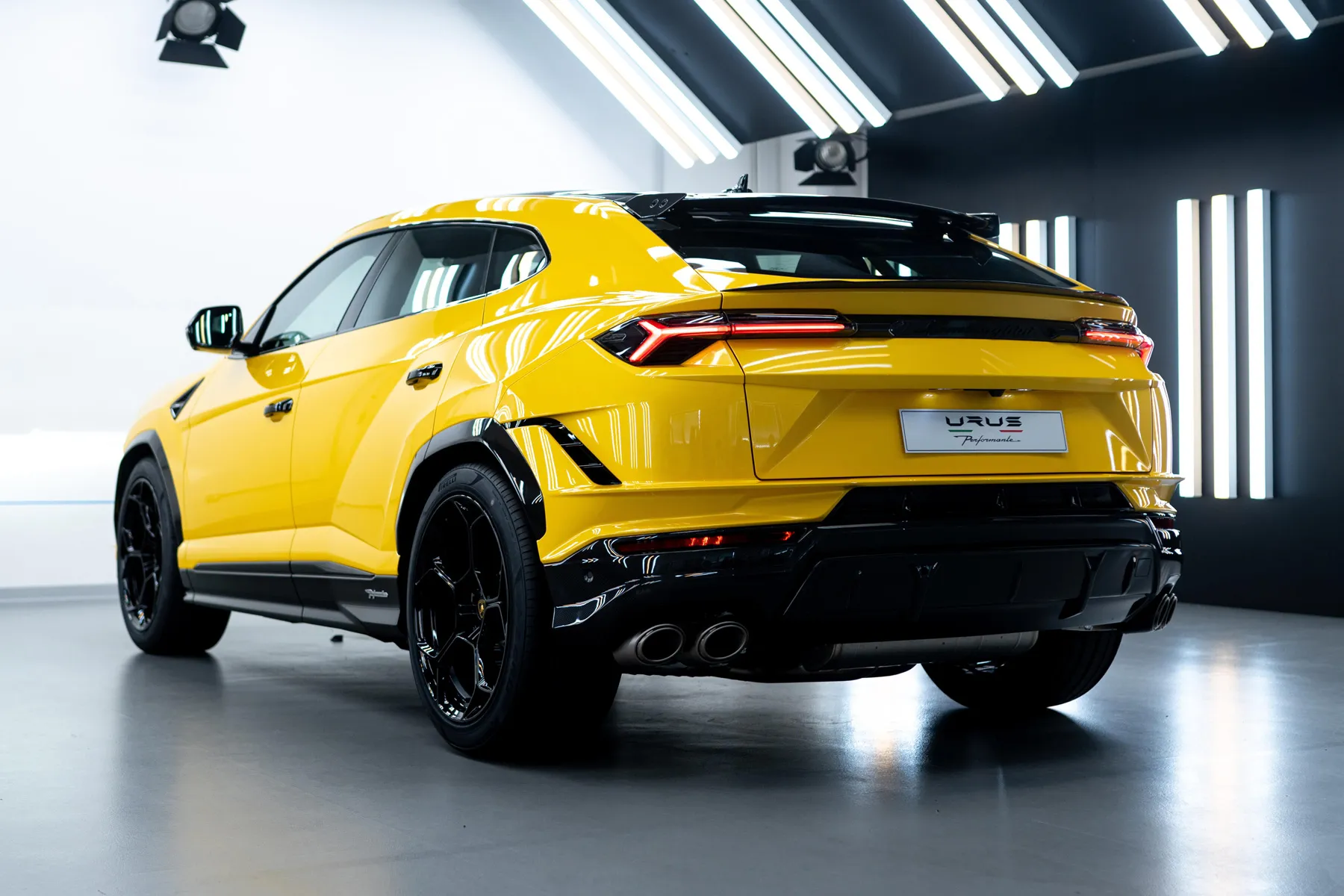Lamborghini Urus Review 2025: Price, specs & boot space
Written by Ivan Aistrop
Quick overview
Pros
- Hugely fast and great to drive
- Strong on interior quality
- Large boot
Cons
- Massively expensive to buy and run
- Limited rear headroom
- Too many touchscreens
Overall verdict on the Lamborghini Urus
"Many Lamborghinis of the past have been fast, thrilling and theatrical, but have failed to serve up much more beyond that. The Urus is different. This is a car that delivers on the drama needed from a Lambo, but also delivers the practicality, comfort and luxury needed to make it a viable everyday proposition."

The world has changed a bit since the Lamborghini Urus was released back in 2018. Today, there’s a general acceptance of the inevitable onslaught of the SUV, and the fact that there’s not a carmaker on the planet that can afford not to make one. Back then, though, the very thought of an SUV wearing the raging bull badge sparked outrage among the car-geek fraternity.
Not that it was Lambo’s first rodeo, mind. The Italian firm had dipped a toe in the water of SUVs back in 1986 when it released the slightly bizarre LM002 - otherwise known as the ‘Rambo Lambo’ - although only 301 were ever built during its seven-year lifespan, so it was hardly a mainstream offering, even by Lamborghini’s standards. The Urus, meanwhile, would be the car to cash in on the public’s ever-growing affection for SUVs, with a production target set at 3,500 cars per year, and sure enough, it quickly became the firm’s best-selling model. So, whatever your view on the Urus’ right to exist, it’s difficult to argue that the car didn’t prove Lamborghini’s point.
For buyers, the appeal of the Urus is simple: it provides all that Lamborghini-ness - the outlandish looks, the devastating pace, the dynamic sharpness, and the soul-stirring noise - in a package that’s practical enough to get your kids to school during the week, and you and your clubs to the golf club at the weekend.
And it does it all rather well, as it goes. The boot is massive, the cabin is spacious enough, and the interior is finished with all the luxury gadgetry you’d expect, while also feeling appropriately posh and sporty.
Flip up the fighter-jet-style starter button cover (yes, really) and fire up the engine, and the snarl of the twin-turbocharged V8 engine delivers a huge dose of drama before you’ve even turned a wheel. And once you do get underway, you’ll enjoy the sort of searing pace and handling ability that make the car plausible as a Lamborghini: okay, so it doesn’t drive exactly like one of the firm’s low-slung sports cars, but it’s pretty darned good. It’s even fairly comfortable when you need it to be.
Yes, the Urus is very, very expensive, but for the well-heeled clientele that buy it, the glamour and exclusivity that this brings will be a huge part of the appeal. And despite the price tag, the car’s all-round ability means its owners will never feel short-changed.
Is the Lamborghini Urus right for you?
There are luxury SUVs, and there are luxury SUVs. In terms of price and status, the Lamborghini Urus finds itself a cut above the likes of Audi, BMW and Range Rover, competing more with the likes of the Bentley Bentayga and Rolls-Royce Cullinan. We’ve driven all three of these cars back to back to compare them directly, and there’s one thing that’s abundantly clear above everything else: if you want the sportiest one of the lot, then it has to be the Lambo.
What’s the best Lamborghini Urus model/engine to choose?
All versions of the Lamborghini Urus have the same twin-turbocharged 4.0-litre V8 petrol engine, mated to an eight-speed automatic gearbox, feeding power to all four wheels. Sure, the later S and Performante models, offered from 2022 onwards, had a smidge more power, but with 641bhp, the original Urus was hardly lacking in that regard, and the uptick in performance - on paper at least - was marginal.
With that in mind, engine and trim spec is largely irrelevant. What’s far more pertinent with a car like the Urus is the nature of the optional extras fitted to any given example you find. The original £160,000 car was a blank canvas to which original owners would add many thousands of pounds worth of optional extras, making the price even more astronomical. So, it’s more about finding a car with the sort of extras and features you want. And don’t go looking for a bargain, because they don’t exist.
What other cars are similar to the Lamborghini Urus?
The Lamborghini Urus is a luxurious sports SUV, and in that regard, it could be considered a rival for things like the Audi Q8, Porsche Cayenne and Volkswagen Touareg - all of which it shares its mechanicals with - along with cars like the BMW X6, Range Rover Sport and Mercedes-AMG GLE.
However, the big Lambo sits quite a bit higher than these cars when it comes to price, landing it in the spectrum of uber-SUVs such as the Bentley Bentayga (which again is heavily related mechanically), the Aston Martin DBX and the Rolls-Royce Cullinan.
Comfort and design: Lamborghini Urus interior
"The interior of the Urus is packed with drama and is dripping with quality, as you’d expect in a car costing this much. It also does a fairly decent job on practicality, with reasonable passenger space and a big boot, so it’s the car you want if you’re after an everyday Lambo."

Like with most Lamborghinis, climb inside the Urus, and you find an interior design that’s full of drama. Take the starter button, for example. It has a fighter jet-style cover that you have to flip up with your thumb before you push it, and that makes you feel more like you’re firing a ballistic missile from underneath the wing of an F16 than starting your car. Meanwhile, the gear selector and drive mode selectors also have a design that’s reminiscent of a fighter jet’s throttle controls. A shameless gimmick these may be, but they’re undeniably effective.
Getting comfortable at the wheel is nice and easy thanks to a driver’s seat with 12-way electric adjustment and a steering column with bags of movement. It’s not all good news, though, because the pedals are slightly offset to the right, and your rear visibility is fairly horrendous. Happily, you get all-round parking sensors and a reversing camera to help with manoeuvres.
Quality and finish
If you’re buying a car from a brand as evocative and as exotic as Lamborghini - and paying this much for it - you’d expect it to feel like a real cut above the norm in terms of quality. Thankfully, you can really see Lambo’s Audi connection here, because the Urus’ interior has much of the look and feel of a high-end offering from its German sister brand. The main structural parts feel solid, substantial and expensive, and there are plenty of flourishes to keep things interesting, with piano black wood and brushed aluminium inserts in the dashboard, an alcantara headliner and leather coverings for the seats, steering wheel and door trims. You might find the odd switch or button shared with an Audi A4 saloon, but it’s not enough to ruin the feeling of grandeur.
Infotainment: Touchscreen, USB, nav and stereo in the Lamborghini Urus
If you’re a fan of smartphone-style touchscreen systems, then you’ll absolutely love the Urus: glance at the centre console, and you’ll notice two of the things. The 8.6-inch one on top takes care of all the regular infotainment functions, while the 10.1-inch below it usually serves as an alternative to conventional air-con controls. OK, we’ll concede that it all looks quite swish, but our view is that, if you’re going to have air-con controls that are separate from the rest of the infotainment system, why not have regular dials and buttons, which require less attention - and are therefore less distracting - than touchscreens on the move.
The top screen uses software and menu layouts that you might recognise from their use in some Audis, so the system is fairly responsive to inputs and it’s reasonably easy to find your way around the various functions. However, the top screen does look a bit small by more modern standards. All of the screens - including the 12.3-inch one behind the steering wheel that displays your driving information - also use graphics and fonts that you’ll recognise from Audi products, so they look clear, legible and slick.
You get all the infotainment functionality you expect, and maybe some you don’t. Satellite navigation with 3D maps, voice control, DAB radio, USB ports, a Bluetooth phone connection and Apple CarPlay and Android Auto are provided, and so are wireless phone charging and a DVD player.
Space and practicality: Lamborghini Urus boot space
You’d expect a car as massive as the Urus to be practical, and it does a reasonably good job here. Let’s put it this way: it’s the most practical Lamborghini you’re likely to come across.
Space in the front seats is generous, and the wide cabin means that there’s plenty of distance between you and your front passenger, so you don’t feel squashed in. In the back of the car, you get either a conventional three-seat bench or two individual seats, and these can be reclined in both formats. Which you'll want will be up to you. You probably won’t want to use the middle-rear seat in the five-seater version too often because it’s a bit hard and the bulky transmission tunnel in the floor in front of it eats into the foot space available, but it is useful to have on those occasions where you need to cram in an extra body on a trip to the Polo club. Whichever seating layout you choose, legroom is very generous in the back of the Urus, but the car’s sloping roofline means that headroom is rather more limited, and anyone much over six-feet tall will find their scalp pressing into the alcantara headlining.
The boot measures 616 litres in the five-seater version, or 574 litres when four seats are fitted. It’s a useful square shape, and a powered tailgate is fitted as standard, although there is a bit of a load lip to lift heavy items over. The rear bench folds down in a useful 40-20-40 split, giving you more versatility than the more common 60-40 layout.
Handling and ride quality: What is the Lamborghini Urus like to drive?
"You might be a shade disappointed if you’re expecting some kind of sports car on stilts, but nevertheless the Urus is still a hugely enjoyable - not to mention hugely impressive - car to drive. It can get across country with electrifying pace, and it’s also comfortable enough for the daily grind."

Normally with an SUV, we’d start this section by talking about ride comfort, because that’s usually the most important thing in an SUV. However, when the SUV in question has a Lamborghini badge on the nose, it’s inevitable that ride comfort will take a back seat to handling prowess. So, how does the Urus perform on that score?
Well, the good news is that it has a variety of clever componentry aimed at making this humongous high-riding hercules of a thing corner like a sports car. The first is an adaptive air suspension that varies its ride height and firmness according to which of the driving modes you select. Strada is the softest, Sport is a bit firmer, while Corsa is firmer still. You also have active anti-roll bars that further help rein-in body lean in corners, and there’s also active four-wheel steering. At low speeds, this turns the rear wheels a few degrees in the opposite direction to the fronts, which helps reduce the turning circle and make the car more manoeuvrable, while at higher speeds, the rears are turned in the same direction to the fronts to make the car turn more quickly and improve stability.
And it’s all enormously effective. Now, don’t go thinking that the Urus feels like some sort of flyweight roadster in the corners, because it doesn’t, and to expect it to would be entirely unreasonable. However, for a car of this size and type, it munches through bends with incredible precision. The responsiveness of the steering means the nose of the car tucks in quickly and accurately, and regardless of the driving mode selected, the body stays impressively flat and level, and there’s an enormous amount of grip and traction provided by the standard four-wheel drive. All this gives you the confidence to push the car hard, even if the steering doesn’t quite offer the feedback necessary to make the car feel truly engaging. However, the speed at which it can move across country is hugely impressive nonetheless.
The S comes with a couple of extra driving modes, mainly for use off-road (not that any Urus buyer is ever going to need those), while the Performante has an additional Rally mode and various lightweight parts that trim 47 kilos off the weight of the car (which seems a little pointless: it’s a bit like lopping the little finger off the Statue of Liberty and then expecting the old girl to fly away). However, we haven’t tried these versions, so we can’t tell you whether they feel any different to drive.
And what about ride comfort? Well, it’s not at all bad, as it happens. In Strada mode, you’ll feel a shade more of the road surface than you will in other hyper-SUVs such as the Bentley Bentayga, but it’s still easily forgiving enough to flatten over rough surfaces without a fuss. You feel the extra edge in Sport mode, but even that’s pliant enough for most roads. Corsa mode is a bit too brittle for the public highway, and should be reserved for if you ever feel the need to take your Urus to a track.
What engines and gearboxes are available in the Lamborghini Urus?
All versions of the Urus get a twin-turbocharged 4.0-litre V8 petrol engine, mated to an eight-speed automatic gearbox. The power is sent to all four wheels, with the larger portion of it directed towards the rears. And that power is certainly not in short supply. In the original Urus, which is the one we’ve driven, the output stands at 641bhp, while max torque sits at 627lb ft. Despite the Urus weighing well over two tonnes, that’s enough shove to propel this enormous car from 0-62mph in just 3.6 seconds, and onto a top speed of 190mph.
It feels every bit as fast as the numbers suggest, too, with off-the-line launches properly pinning you back in your seat, and hugely strong on-the-move acceleration only ever a gentle prod of your right foot away. Stick with Strada mode, and the gearshifts are brisk but smooth, and the transmission always seems to select the right cog at the first time of asking. Select the Sport or Corsa modes, the transmission punches up and down the ratios with progressive amounts of aggression, while the exhaust spits and crackles for even more drama. You can wrestle back control of the gearchanges by using the steering-mounted paddles, and the transmission always responds quickly to your orders, while the standard carbon-ceramic brakes provide huge stopping power and a decent amount of feel. Make no mistake, this is a hugely fast car, with a level of pace that will make you never for a second doubt whether it deserves to wear a Lamborghini badge.
When the S and the Performante versions came along in 2022, these were given slightly more power, with the wick being turned up to 657bhp. The S version trims the 0-62mph dash time to 3.5 seconds, while the lighter Performante trims it to just 3.3 seconds. We’ve not tried these versions, but given the effortless ferocity of the standard car, you can be pretty confident that they won’t hang about.
Refinement and noise levels
As we’ve already said, the V8 engine sounds appropriately naughty in Sport and Corsa modes, which is central to the experience when you’re getting a move-on. When you’re not, and you’re just wanting to get home after a long day, selecting Strada makes things quieter. It’s not Rolls-Royce levels of tranquility, and the engine is always audible in the background, but it’s quiet enough to make life effortlessly civilised. You won’t hear a vast amount in the way of wind noise, either, but the car’s fat tyres do inevitably kick up a bit of road noise.
Safety equipment: How safe is the Lamborghini Urus?
The Urus comes with most of the safety kit you expect. You have driver aids such as autonomous emergency braking, lane departure warning and lane-keep assist to help you avoid having an accident in the first place, and six airbags and E-Call emergency assistance just in case the worst happens. However, you might expect more given the money you’re spending. For instance, the cruise control is merely a passive system, not the semi-autonomous adaptive system you might be expecting.
Euro NCAP doesn’t tend to crash test cars like the Urus. They don’t sell in high enough numbers to warrant it, and smashing them to smithereens is a prohibitively expensive business. So, with no test results to go on, it’s not clear how well the car would fare in a crash.
MPG and fuel costs: What does a Lamborghini Urus cost to run?
"What does a Lamborghini Urus cost to run? At the risk of sounding sarcastic, it’s a Lamborghini. It’ll cost an absolute shedload to run at every stage of the game. Fuel, insurance, maintenance, repairs, tyres - it’ll all be positively astronomical."

You’d expect any Lamborghini to put away fuel like there’s no tomorrow, and one weighing more than 2.2 tonnes might struggle to control its thirst even more. So it’ll come as no surprise that the Urus’ appetite for unleaded is fairly insatiable. According to the official figures, an angelically driven Urus can eke out a combined return of around 22mpg. But let’s face it, if you’re going to all the expense of buying an Urus, how often are you really likely to drive it angelically? Hardly ever, we’d wager, and why should you? And when you do inevitably give into temptation, it won’t be long before you’re in the low teens, while really hardcore use will have you down into single-figure territory. Then again, if you can afford to buy an Urus, you’re unlikely to be fazed by the cost of putting petrol in it.
How reliable is the Lamborghini Urus?
Although the Urus is the biggest-selling Lamborghini there is, the firm still sells cars in relatively modest numbers, modest enough that it doesn’t feature in the various reliability and customer satisfaction surveys doing the rounds, and that includes the HonestJohn.co.uk Satisfaction Index.
Of course, Lamborghini’s cars - along with the offerings of pretty much every Italian supercar manufacturer - have traditionally had a reputation for being highly strung and prone to catastrophic faults on a regular basis, but the firm’s connection with Audi over the last few years has seen this reputation dwindle, although do be aware that if repairs to your car are needed, they’ll likely be astronomically expensive.
Insurance groups and costs
All cars are bestowed with their own insurance rating on a scale of 1 to 50. Cars in group 1 are the cheapest to insure, while those in group 50 are the most expensive. Now, it probably won’t stagger you to learn that a car like the Lamborghini Urus - with its six-figure price tag and upwards of 600 horsepower - sits at the very upper end of that scale in group 50. However, it’s also true that if you have the financial means to buy an Urus, then you can probably afford to insure it, too.
VED car tax: What is the annual road tax on a Lamborghini Urus?
Again, if you’re wealthy enough to seriously consider buying and running a Lamborghini Urus, then the price of a now-metaphorical tax disc probably isn’t going to keep you awake at night. For the record, you pay the same flat rate of annual tax as you do on every petrol-powered car, which standards at £180, and because the Urus costs more than £40,000 when new (quite a bit more, as it happens…), you’re also required to pay an additional surcharge of £390 per year between years two and six of the car’s life. That takes your annual VED tax outlay for that period to £570.
How much should you be paying for a used Lamborghini Urus?
"There’s no such thing as a cheap Lamborghini, and the Urus SUV is no exception. Purchase prices were astronomical when new, and used examples haven’t shipped all that much value, either, so don’t go expecting any used car bargains."

You know the phrase ‘if you have to ask, then you probably can’t afford it’? Well that kind of applies here. When the Urus was first launched back in 2018, prices started at around £160,000. However, that was just a starting point for negotiations, because all manner of ludicrously expensive optional extras were on offer to tempt the well-heeled folk who bought them brand new, and the average purchase price of a car in its final spec would be way, way more than that. If you kept it under £200,000, then you were being miserly.
What’s more, as with everything in life, prices have been on the rise ever since, and the S and Performante models were more expensive still.
Due to the desirability of the car, don’t go expecting too many bargains on the used market, either. Look at our listings, and most of the examples you’ll find are a couple of years old, but with teeny mileages, so they’re still commanding the sort of prices that you’d have paid brand new, and in some cases probably more. There are a few to be found with higher mileages - around 30,000 to 40,000 - and these can be had for around the original starting price, but rest assured, there’s no such thing as a cheap Urus.
Trim levels and standard equipment
We’ve already talked about the level of standard kit you get with the Urus when it comes to safety and the all-important area of infotainment, and the news on both scores is largely good. As it jolly well should be when you’re spending so much cash.
The car also comes with a decent amount of luxury items, too, again, as it should. These include heated front seats with 12-way powered adjustment, keyless entry and go, cruise control, all-round LED lighting with high-beam assist headlights, front and rear parking sensors, a powered tailgate, leather upholstery and an alcantara headliner.
Ask the heycar experts: common questions
Is the Lamborghini Urus a good everyday car?
Does the Lamborghini Urus hold its value?
Is the Lamborghini the best SUV you can buy?
Get our latest advice, news and offers
Keep me updated by email with the latest advice, news and offers from heycar.
By submitting you agree to our privacy policy



